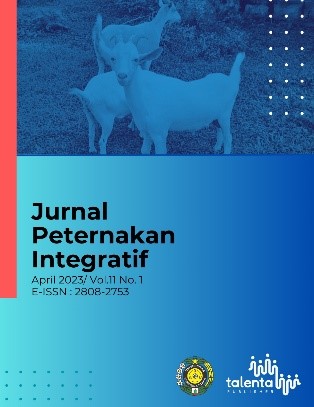Biogas Productivity Using Cow Feces Input and Palm Oil Empty Affluent Soaking Water
DOI:
https://doi.org/10.32734/jpi.v11i1.11456Keywords:
Biogas, Bioactivator, Cow faeces, Empty palm fruit bunches, Gas pressureAbstract
Soaking water of empty palm oil fruit bunches is a waste that is usually disposed of in straw mushroom cultivation. It turns out that this soaking water still contains nutrients, so it is suitable as input for biogas along with cow faeces. Therefore a study was carried out while the treatments used were P0 (cow faeces + empty palm oil bunches soaking water) and P1 (cow faeces + empty palm oil bunches soaking water + 5% bioactivator). All biogas input was fermented for 28 days, and the fermentation parameters were gas pH, gas pressure, gas volume, flame test and colour. The results showed that adding 5% bio activator significantly affected the gas produced. Maximum production in both treatments occurred on day 28, i.e. cow feces + empty palm oil bunches soaking water with a pH of 7.61, resulting in a gas pressure of 416.925 pa and a gas volume of 20 L. Meanwhile, cow faeces + empty palm oil bunches soaking water + 5% bioactivator cause a pH of 7.91, produces a gas pressure of 588.6 pa and a gas volume of 30 L.
Downloads
Downloads
Published
Issue
Section
License
Copyright (c) 2023 Jurnal Peternakan Integratif

This work is licensed under a Creative Commons Attribution-ShareAlike 4.0 International License.
The Authors submitting a manuscript do so on the understanding that if accepted for publication, copyright of the article shall be assigned to Jurnal Peternakan Integratif as well as TALENTA Publisher Universitas Sumatera Utara as the publisher of the journal.
Copyright encompasses exclusive rights to reproduce and deliver the article in all forms and media. The reproduction of any part of this journal, its storage in databases and its transmission by any form or media, will be allowed only with written permission from Jurnal Peternakan Integratif.
The Copyright Transfer Form can be downloaded here.
The copyright form should be signed originally and sent to the Editorial Office in the form of original mail or scanned document.















